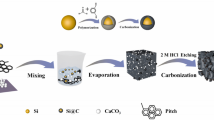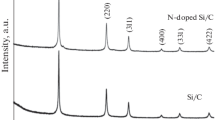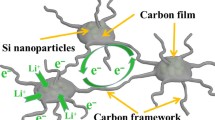Abstract
Silicon (Si) is a promising anode candidate for next-generation lithium-ion batteries (LIBs), but it suffers from poor electronic conductivity and dramatic volume variation during cycling, which poses a critical challenge for stable battery operation. To mitigate these issues simultaneously, we propose a “double carbon synergistic encapsulation” strategy, namely thin carbon shell and nitrogen/phosphorus co-doped two-dimensional (2D) carbon sheet dual encapsulate Si nanoparticles (denoted as 2D NPC/C@Si). This double carbon structure can serve as a conductive medium and buffer matrix to accommodate the volume expansion of Si nanoparticles and enable fast electron/ion transport, which promotes the formation of a stable solid electrolyte interphase film during cycling. Through structural advantages, the resulting 2D NPC/C@Si electrode demonstrates a high reversible capacity of 592 mAh·g−1 at 0.2 A·g−1 with 90.5% excellent capacity retention after 100 cycles, outstanding rate capability (148 mAh·g−1 at 8 A·g−1), and superior long-term cycling stability (326 mAh·g−1 at 1 A·g−1 for 500 cycles, 86% capacity retention). Our findings elucidate the development of high-performance Si@C composite anodes for advanced LIBs.




Similar content being viewed by others

References
Schmuch R, Wagner R, Hörpel G, Placke T, Winter M. Performance and cost of materials for lithium-based rechargeable automotive batteries. Nat Energy. 2018;3:267.
Zuo JH, Gong YJ. Applications of transition-metal sulfides in the cathodes of lithium-sulfur batteries. Tungsten. 2020;2(2):134.
Guo F, Chen P, Kang T, Wang YL, Liu CH, Shen YB, Lu W, Chen LW. Silicon-loaded lithium-carbon composite microspheres as lithium secondary battery anodes. Acta Phys-Chim Sin. 2019;35(12):1365.
Wang HK, Qian RF, Cheng YH, Wu HH, Wu XW, Pan KM, Zhang QB. Micro/nanostructured TiNb2O7-related electrode materials for high-performance electrochemical energy storage: recent advances and future prospects. J Mater Chem A. 2020;8(36):18425.
Zhang QB, Gong ZL, Yang Y. Advance in interface and characterizations of sulfide solid electrolyte materials. Acta Phys Sin. 2020;69(22):228803.
Zheng SQ, Wu ZH, Wang JT, Zhang XJ. Performance of high capacity silicon/carbon anodes with different pore structures. Chin J Rare Met. 2020;3(44):225.
Li XL, Gu M, Hu SY, Kennard R, Yan PF, Chen XL, Wang CM, Sailor MJ, Zhang JG, Liu J. Mesoporous silicon sponge as an anti-pulverization structure for high-performance lithium-ion battery anodes. Nat Commun. 2014;5:4105.
An WL, Gao B, Mei SX, Xiang B, Fu JJ, Wang L, Zhang QB, Chu PK, Huo KF. Scalable synthesis of ant-nest-like bulk porous silicon for high-performance lithium-ion battery anodes. Nat Commun. 2019;10:1447.
Ko M, Chae S, Cho J. Challenges in accommodating volume change of Si anodes for Li-ion batteries. Chem Electro Chem. 2015;2(11):1645.
Ko M, Chae S, Ma J, Kim N, Lee HW, Cui Y, Cho J. Scalable synthesis of silicon-nanolayer-embedded graphite for high-energy lithium-ion batteries. Nat Energy. 2016;1:16113.
Wu ZL, Ji SB, Liu LK, Xie T, Tan L, Tang H. High-performance SiO/C as anode materials for lithium-ion batteries using commercial SiO and glucose as raw materials. Rare Met. 2020. https://doi.org/10.1007/s12598-020-01445-x.
Li XY, Qu JK, Yin HY. Electrolytic alloy-type anodes for metal-ion batteries. Rare Met. 2020. https://doi.org/10.1007/s12598-020-01537-8.
Lee JH, Yoon CS, Hwang JY, Kim SJ, Maglia F, Lamp P, Myung ST, Sun YK. High-energy-density lithium-ion battery using a carbon-nanotube–Si composite anode and a compositionally graded Li[Ni0.85Co0.05Mn0.10]O2 cathode. Energy Environ Sci. 2016;9(6):2152.
Chen DY, Mei X, Ji G, Lu MH, Xie JP, Lu JM, Lee JY. Reversible lithium-ion storage in silver-treated nanoscale hollow porous silicon particles. Angew Chem Int Ed Engl. 2012;124(10):2459.
Liu N, Lu ZD, Zhao J, McDowell MT, Lee HW, Zhao WT, Cui Y. A pomegranate-inspired nanoscale design for large-volume-change lithium battery anodes. Nat Nanotechnol. 2014;9:187.
Li J, Yang JY, Wang JT, Lu SG. A scalable synthesis of silicon nanoparticles as high-performance anode material for lithium-ion batteries. Rare Met. 2017;38(3):199.
Liu JY, Zheng QY, Goodman MD, Zhu HY, Kim J, Krueger NA, Ning HL, Huang XJ, Liu JH, Terrones M, Braun PV. Graphene sandwiched mesostructured Li-ion battery electrodes. Adv Mater. 2016;28(35):7696.
Son IH, Hwan Park J, Kwon S, Park S, Rummeli MH, Bachmatiuk A, Song HJ, Ku J, Choi JW, Choi JM, Doo SG, Chang H. Silicon carbide-free graphene growth on silicon for lithium-ion battery with high volumetric energy density. Nat Commun. 2015;6:7393.
An HF, Jiang L, Li F, Wu P, Zhu XS, Wei SH, Zhou YM. Hydrogel-derived three-dimensional porous Si-CNT@G nanocomposite with high-performance lithium storage. Acta Phys-Chim Sin. 2020;36(7):1905034.
Wu SJ, Wu ZH, Fang S, Qi XP, Yu B, Yang JY. A comparison of core–shell Si/C and embedded structure Si/C composites as negative materials for lithium-ion batteries. Rare Met. 2019. https://doi.org/10.1007/s12598-019-01354-8.
Xiang B, An WL, Fu JJ, Mei SX, Guo SG, Zhang XM, Gao B, Chu PK. Graphene-encapsulated blackberry-like porous silicon nanospheres prepared by modest magnesiothermic reduction for high-performance lithium-ion battery anode. Rare Met. 2020. https://doi.org/10.1007/s12598-020-01528-9.
Zhang QB, Chen HX, Luo LL, Zhao B, Luo H, Han X, Wang JW, Wang CM, Yang Y, Zhu T, Liu ML. Harnessing the concurrent reaction dynamics in active Si and Ge to achieve high performance lithium-ion batteries. Energy Environ Sci. 2018;11(3):669.
Xu Q, Sun JK, Yu ZL, Yin YX, Xin S, Yu SH, Guo YG. SiOx encapsulated in graphene bubble film: an ultrastable Li-ion battery anode. Adv Mater. 2018;30(25):1707430.
Yao Y, McDowell MT, Ryu I, Wu H, Liu N, Hu LB, Nix WD, Cui Y. Interconnected silicon hollow nanospheres for lithium-ion battery anodes with long cycle life. Nano Lett. 2011;11(7):2949.
Wu H, Chan G, Choi JW, Ryu I, Yao Y, McDowell MT, Lee SW, Jackson A, Yang Y, Hu L, Cui Y. Stable cycling of double-walled silicon nanotube battery anodes through solid-electrolyte interphase control. Nat Nanotechnol. 2012;7(5):310.
Xia F, Kim SB, Cheng HY, Lee JM, Song T, Huang YG, Rogers JA, Paik U, Park WI. Facile synthesis of free-standing silicon membranes with three-dimensional nanoarchitecture for anodes of lithium ion batteries. Nano Lett. 2013;13(7):3340.
Zheng ZM, Wu HH, Liu HL, Zhang QB, He X, Yu SC, Petrova V, Feng J, Kostecki R, Liu P, Peng DL, Liu M, Wang MS. Achieving fast and durable lithium storage through amorphous FeP nanoparticles encapsulated in ultrathin 3D P-doped porous carbon nanosheets. ACS Nano. 2020;14(8):9545.
Chen SQ, Shen LF, van Aken PA, Maier J, Yu Y. Dual-functionalized double carbon shells coated silicon nanoparticles for high performance lithium-ion batteries. Adv Mater. 2017;29(21):1605650.
Chen QH, Cheng Y, Liu HD, Zhang QB, Petrova V, Chen HX, Liu P, Peng DL, Liu ML, Wang MS. Hierarchical design of Mn2P nanoparticles embedded in N, P-codoped porous carbon nanosheets enables highly durable lithium storage. ACS Appl Mater Interfaces. 2020;12(32):36247.
Wu HL, Xia L, Ren J, Zheng QJ, Xu CG, Lin DM. A high-efficiency N/P co-doped graphene/CNT@porous carbon hybrid matrix as a cathode host for high performance lithium–sulfur batteries. J Mater Chem A. 2017;5(38):20458.
Lyu FC, Zeng SS, Sun ZF, Qin N, Cao LJ, Wang ZY, Jia Z, Wu SF, Ma FX, Li MC, Wang WX, Li YY, Lu J, Lu Z. Lamellarly stacking porous N, P co-doped Mo2C/C nanosheets as high performance anode for lithium-ion batteries. Small. 2019;15(8):1805022.
Gan CH, Zhang CK, Wen WD, Liu YK, Chen J, Xie QS, Luo XT. Enhancing delithiation reversibility of Li15Si4 alloy of silicon nanoparticles-carbon/graphite anode materials for stable-cycling lithium ion batteries by restricting the silicon particle size. ACS Appl Mater Interfaces. 2019;11(39):35809.
Wang MS, Wang GL, Wang S, Zhang J, Wang J, Zhong W, Tang F, Yang ZL, Zheng JM, Li X. In situ catalytic growth 3D multi-layers graphene sheets coated nano-silicon anode for high performance lithium-ion batteries. Chem Eng J. 2019;356:895.
Yao CL, Xu JL, Zhu YP, Zhang RL, Shen YH, Xie AJ. Porous CoP@N/P co-doped carbon/CNTs nanocubes: in-situ autocatalytic synthesis and excellent performance as the anode for lithium-ion batteries. Appl Surf Sci. 2020;513:145777.
Zuo XX, Wang XY, Xia YG, Yin SS, Ji Q, Yang ZH, Wang MM, Zheng XF, Qiu B, Liu ZP, Zhu J, Müller-Buschbaum P, Cheng YJ. Silicon/carbon lithium-ion battery anode with 3D hierarchical macro-/mesoporous silicon network: self-templating synthesis via magnesiothermic reduction of silica/carbon composite. J Power Sour. 2019;412:93.
Bai J, Xi BJ, Mao HZ, Lin Y, Ma XJ, Feng JK, Xiong SL. One-step construction of N, P-codoped porous carbon sheets/CoP hybrids with enhanced lithium and potassium storage. Adv Mater. 2018;30(35):1802310.
Pu ZH, Amiinu IS, Zhang CT, Wang M, Kou ZK, Mu SC. Phytic acid-derivative transition metal phosphides encapsulated in N, P-codoped carbon: an efficient and durable hydrogen evolution electrocatalyst in a wide pH range. Nanoscale. 2017;9(10):3555.
Zeng YF, Huang YD, Liu NT, Wang XC, Zhang Y, Guo Y, Wu HH, Chen HX, Tang XC, Zhang QB. N-doped porous carbon nanofibers sheathed pumpkin-like Si/C composites as free-standing anodes for lithium-ion batteries. J Energy Chem. 2021;54:727.
Pan DY, Wang S, Zhao B, Wu MH, Zhang HJ, Wang Y, Jiao Z. Li storage properties of disordered graphene nanosheets. Chem Mater. 2009;21(14):3136.
Kwon HJ, Hwang JY, Shin HJ, Jeong MG, Chung KY, Sun YK, Jung HG. Nano/microstructured silicon-carbon hybrid composite particles fabricated with corn starch biowaste as anode materials for Li-ion batteries. Nano Lett. 2019;20(1):625.
Xu Q, Li JY, Sun JK, Yin YX, Wan LJ, Guo YG. Watermelon-inspired Si/C microspheres with hierarchical buffer structures for densely compacted lithium-ion battery anodes. Adv Energy Mater. 2017;7(3):1601481.
Zhang HR, Qin XY, Wu JX, He YB, Du HD, Li BH, Kang FY. Electrospun core–shell silicon/carbon fibers with an internal honeycomb-like conductive carbon framework as an anode for lithium ion batteries. J Mater Chem A. 2015;3(13):7112.
Kim WS, Choi J, Hong SH. Meso-porous silicon-coated carbon nanotube as an anode for lithium-ion battery. Nano Res. 2016;9(7):2174.
Zheng ZM, Wu HH, Chen HX, Cheng Y, Zhang QB, Xie QS, Wang LS, Zhang KL, Wang MS, Peng DL, Zeng XC. Fabrication and understanding of Cu3Si-Si@carbon@graphene nanocomposites as high-performance anodes for lithium-ion batteries. Nanoscale. 2018;10(47):22203.
Chen SQ, Bao PT, Huang XD, Sun B, Wang GX. Hierarchical 3D mesoporous silicon@graphene nanoarchitectures for lithium ion batteries with superior performance. Nano Res. 2014;7(1):85.
Zhou XY, Tang JJ, Yang J, Xie J, Ma LL. Silicon@carbon hollow core–shell heterostructures novel anode materials for lithium ion batteries. Electrochim Acta. 2013;87:663.
Wang MS, Fan LZ. Silicon/carbon nanocomposite pyrolyzed from phenolic resin as anode materials for lithium-ion batteries. J Power Sour. 2013;244:570.
Zheng ZM, Li P, Huang J, Liu HD, Zao Y, Hu ZL, Zhang L, Chen HX, Wang MS, Peng DL, Zhang QB. High performance columnar-like Fe2O3@carbon composite anode via yolk@shell structural design. J Energy Chem. 2020;41:126.
Su LW, Zhou Z, Ren MM. Core double-shell Si@SiO2@C nanocomposites as anode materials for Li-ion batteries. Chem Commun. 2010;46(15):2590.
Wang JY, Liao L, Li YZ, Zhao J, Shi FF, Yan K, Pei A, Chen GX, Li GD, Lu ZY, Cui Y. Shell-protective secondary silicon nanostructures as pressure-resistant high-volumetric-capacity anodes for lithium-ion batteries. Nano Lett. 2018;18(11):7060.
Zhou H, Zhu S, Hibino M, Honma I, Ichihara M. Lithium storage in ordered mesoporous carbon (CMK-3) with high reversible specific energy capacity and good cycling performance. Adv Mater. 2003;15(24):2107.
Acknowledgements
This study was financially supported by the National Natural Science Foundation of China (Grant Nos. 52072323, 21805278 and 51872098), the Leading Project Foundation of Science Department of Fujian Province (No. 2018H0034), the “Double-First Class” Foundation of Materials and Intelligent Manufacturing Discipline of Xiamen University, the Opening Project of National Joint Engineering Research Center for Abrasion Control and Molding of Metal Materials, and Henan Key Laboratory of High-temperature Structural and Functional Materials, Henan University of Science and Technology (No. HKDNM2019013).
Author information
Authors and Affiliations
Corresponding author
Supplementary information
Rights and permissions
About this article
Cite this article
Ke, CZ., Liu, F., Zheng, ZM. et al. Boosting lithium storage performance of Si nanoparticles via thin carbon and nitrogen/phosphorus co-doped two-dimensional carbon sheet dual encapsulation. Rare Met. 40, 1347–1356 (2021). https://doi.org/10.1007/s12598-021-01716-1
Received:
Revised:
Accepted:
Published:
Issue Date:
DOI: https://doi.org/10.1007/s12598-021-01716-1



